ECU Hyundai Elantra 2004 Owner's Manual
[x] Cancel search | Manufacturer: HYUNDAI, Model Year: 2004, Model line: Elantra, Model: Hyundai Elantra 2004Pages: 241, PDF Size: 6.5 MB
Page 15 of 241
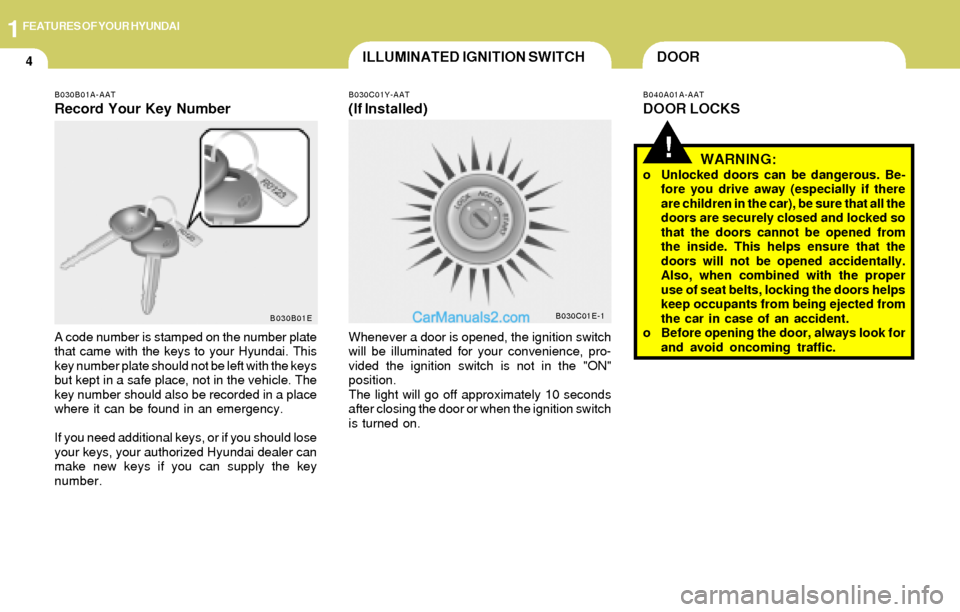
1FEATURES OF YOUR HYUNDAI
4ILLUMINATED IGNITION SWITCH
!
DOOR
B030B01A-AAT
Record Your Key Number
A code number is stamped on the number plate
that came with the keys to your Hyundai. This
key number plate should not be left with the keys
but kept in a safe place, not in the vehicle. The
key number should also be recorded in a place
where it can be found in an emergency.
If you need additional keys, or if you should lose
your keys, your authorized Hyundai dealer can
make new keys if you can supply the key
number.
B030C01Y-AAT
(If Installed)
Whenever a door is opened, the ignition switch
will be illuminated for your convenience, pro-
vided the ignition switch is not in the "ON"
position.
The light will go off approximately 10 seconds
after closing the door or when the ignition switch
is turned on.
B040A01A-AAT
DOOR LOCKS
B030B01EB030C01E-1
WARNING:o Unlocked doors can be dangerous. Be-
fore you drive away (especially if there
are children in the car), be sure that all the
doors are securely closed and locked so
that the doors cannot be opened from
the inside. This helps ensure that the
doors will not be opened accidentally.
Also, when combined with the proper
use of seat belts, locking the doors helps
keep occupants from being ejected from
the car in case of an accident.
o Before opening the door, always look for
and avoid oncoming traffic.
Page 23 of 241
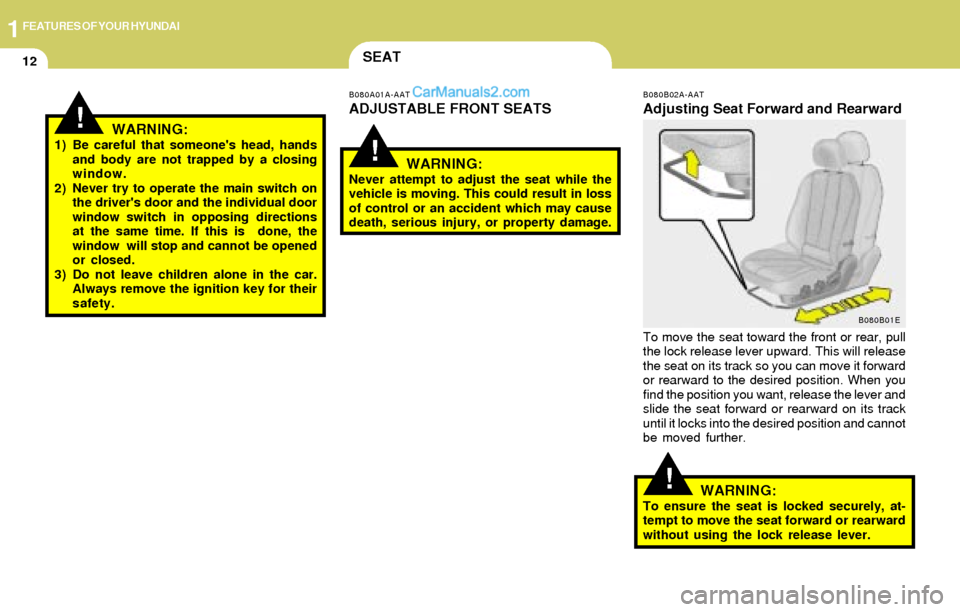
1FEATURES OF YOUR HYUNDAI
12
!
!WARNING:1) Be careful that someone's head, hands
and body are not trapped by a closing
window.
2) Never try to operate the main switch on
the driver's door and the individual door
window switch in opposing directions
at the same time. If this is done, the
window will stop and cannot be opened
or closed.
3) Do not leave children alone in the car.
Always remove the ignition key for their
safety.
B080A01A-AAT
ADJUSTABLE FRONT SEATS
WARNING:
Never attempt to adjust the seat while the
vehicle is moving. This could result in loss
of control or an accident which may cause
death, serious injury, or property damage.
SEAT
B080B02A-AAT
Adjusting Seat Forward and Rearward
To move the seat toward the front or rear, pull
the lock release lever upward. This will release
the seat on its track so you can move it forward
or rearward to the desired position. When you
find the position you want, release the lever and
slide the seat forward or rearward on its track
until it locks into the desired position and cannot
be moved further.
B080B01E
!WARNING:To ensure the seat is locked securely, at-
tempt to move the seat forward or rearward
without using the lock release lever.
Page 29 of 241
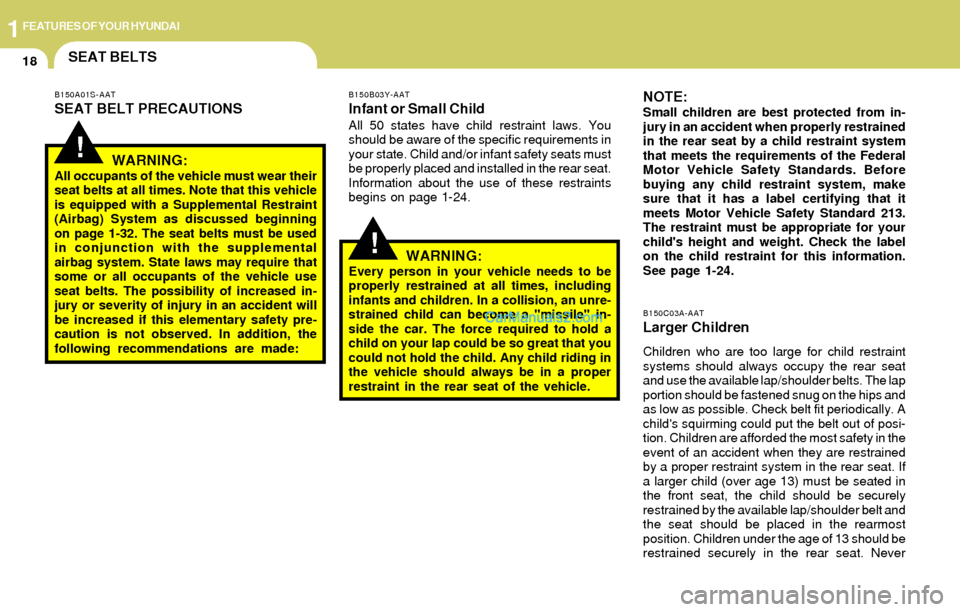
1FEATURES OF YOUR HYUNDAI
18SEAT BELTS
!
!
B150A01S-AAT
SEAT BELT PRECAUTIONS
WARNING:
All occupants of the vehicle must wear their
seat belts at all times. Note that this vehicle
is equipped with a Supplemental Restraint
(Airbag) System as discussed beginning
on page 1-32. The seat belts must be used
in conjunction with the supplemental
airbag system. State laws may require that
some or all occupants of the vehicle use
seat belts. The possibility of increased in-
jury or severity of injury in an accident will
be increased if this elementary safety pre-
caution is not observed. In addition, the
following recommendations are made:
B150B03Y-AAT
Infant or Small ChildAll 50 states have child restraint laws. You
should be aware of the specific requirements in
your state. Child and/or infant safety seats must
be properly placed and installed in the rear seat.
Information about the use of these restraints
begins on page 1-24.
WARNING:Every person in your vehicle needs to be
properly restrained at all times, including
infants and children. In a collision, an unre-
strained child can become a "missile" in-
side the car. The force required to hold a
child on your lap could be so great that you
could not hold the child. Any child riding in
the vehicle should always be in a proper
restraint in the rear seat of the vehicle.
B150C03A-AATLarger Children
Children who are too large for child restraint
systems should always occupy the rear seat
and use the available lap/shoulder belts. The lap
portion should be fastened snug on the hips and
as low as possible. Check belt fit periodically. A
child's squirming could put the belt out of posi-
tion. Children are afforded the most safety in the
event of an accident when they are restrained
by a proper restraint system in the rear seat. If
a larger child (over age 13) must be seated in
the front seat, the child should be securely
restrained by the available lap/shoulder belt and
the seat should be placed in the rearmost
position. Children under the age of 13 should be
restrained securely in the rear seat. Never
NOTE:Small children are best protected from in-
jury in an accident when properly restrained
in the rear seat by a child restraint system
that meets the requirements of the Federal
Motor Vehicle Safety Standards. Before
buying any child restraint system, make
sure that it has a label certifying that it
meets Motor Vehicle Safety Standard 213.
The restraint must be appropriate for your
child's height and weight. Check the label
on the child restraint for this information.
See page 1-24.
Page 32 of 241
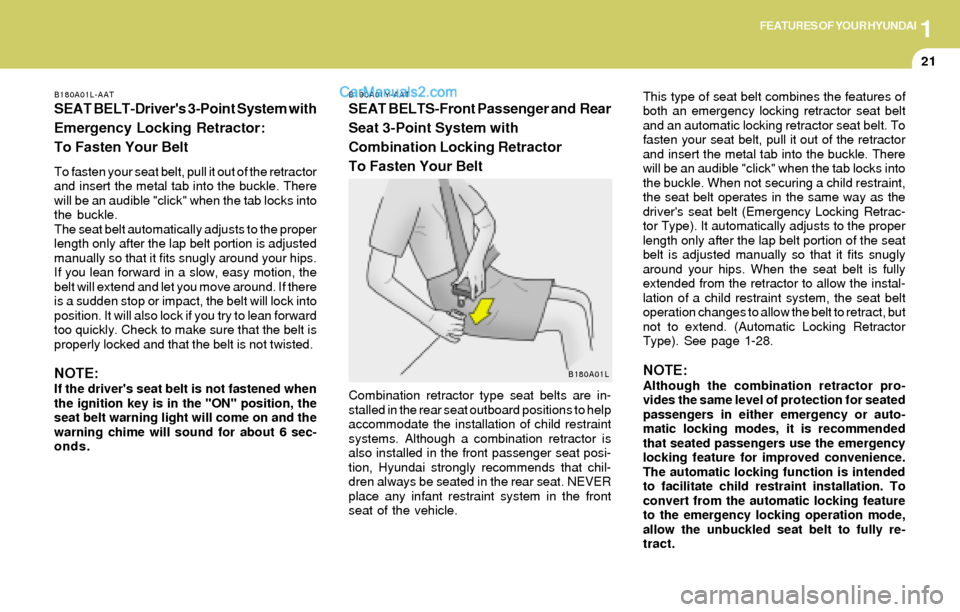
1FEATURES OF YOUR HYUNDAI
21
B180A01L-AAT
SEAT BELT-Driver's 3-Point System with
Emergency Locking Retractor:
To Fasten Your Belt
To fasten your seat belt, pull it out of the retractor
and insert the metal tab into the buckle. There
will be an audible "click" when the tab locks into
the buckle.
The seat belt automatically adjusts to the proper
length only after the lap belt portion is adjusted
manually so that it fits snugly around your hips.
If you lean forward in a slow, easy motion, the
belt will extend and let you move around. If there
is a sudden stop or impact, the belt will lock into
position. It will also lock if you try to lean forward
too quickly. Check to make sure that the belt is
properly locked and that the belt is not twisted.
NOTE:If the driver's seat belt is not fastened when
the ignition key is in the "ON" position, the
seat belt warning light will come on and the
warning chime will sound for about 6 sec-
onds.
B190A01Y-AAT
SEAT BELTS-Front Passenger and Rear
Seat 3-Point System with
Combination Locking Retractor
To Fasten Your BeltThis type of seat belt combines the features of
both an emergency locking retractor seat belt
and an automatic locking retractor seat belt. To
fasten your seat belt, pull it out of the retractor
and insert the metal tab into the buckle. There
will be an audible "click" when the tab locks into
the buckle. When not securing a child restraint,
the seat belt operates in the same way as the
driver's seat belt (Emergency Locking Retrac-
tor Type). It automatically adjusts to the proper
length only after the lap belt portion of the seat
belt is adjusted manually so that it fits snugly
around your hips. When the seat belt is fully
extended from the retractor to allow the instal-
lation of a child restraint system, the seat belt
operation changes to allow the belt to retract, but
not to extend. (Automatic Locking Retractor
Type). See page 1-28.
NOTE:Although the combination retractor pro-
vides the same level of protection for seated
passengers in either emergency or auto-
matic locking modes, it is recommended
that seated passengers use the emergency
locking feature for improved convenience.
The automatic locking function is intended
to facilitate child restraint installation. To
convert from the automatic locking feature
to the emergency locking operation mode,
allow the unbuckled seat belt to fully re-
tract. Combination retractor type seat belts are in-
stalled in the rear seat outboard positions to help
accommodate the installation of child restraint
systems. Although a combination retractor is
also installed in the front passenger seat posi-
tion, Hyundai strongly recommends that chil-
dren always be seated in the rear seat. NEVER
place any infant restraint system in the front
seat of the vehicle.B180A01L
Page 35 of 241

1FEATURES OF YOUR HYUNDAI
24CHILD RESTRAINT SYSTEM
!
B220C01Y-AAT
To Release the Seat Belt
When you want to release the seat belt, press
the button in the locking buckle.
WARNING:The rear seat center belt latching mecha-
nism is different from those for the out-
board rear seat shoulder belts. When fas-
tening the outboard rear seat shoulder belts
or the rear seat center belt, make sure they
are inserted into the correct buckles to
obtain maximum protection from the seat
belt system and assure proper operation.
B230A02A-AAT
Children riding in the car should sit in the rear
seat and must always be properly restrained to
minimize the risk of injury in an accident, sudden
stop or sudden maneuver. According to acci-
dent statistics provided by the National High-
way Traffic Safety Administration (NHTSA),
children are safer when properly restrained in
the rear seats than in the front seat. Larger
children not in a child restraint should use one
of the seat belts provided.
All 50 states have child restraint laws. You
should be aware of the specific requirements in
your state. Child and/or infant safety seats must
be properly placed and installed in the rear seat.
You must use a commercially available child
restraint system that meets the requirements of
the Federal Motor Vehicle Safety Standards
(FMVSS).
Children could be injured or killed in a crash if
their restraints are not properly secured. For
small children and babies, a child seat or infant
seat must be used. Before buying a particular
child restraint system, make sure it fits your car
and seat belts, and fits your child. Follow all the
instructions provided by the manufacturer when
installing the child restraint system.
B220C01E
!WARNING:o A child restraint system must be placed
in the rear seat. Never install a child or
infant seat on the front passenger's seat.
Should an accident occur and cause the
passenger side airbag to deploy, it could
severely injure or kill an infant or child
seated in an infant or child seat. Thus,
only use a child restraint in the rear seat
of your vehicle.
o Since a safety belt or child restraint sys-
tem can become very hot if it is left in a
closed vehicle, be sure to check the seat
cover and buckles before placing a child
there.
o When the child restraint system is not in
use, store it in the trunk or fasten it with
a safety belt so that it will not be thrown
forward in the case of a sudden stop or
an accident.
o Children who are too large to be in a child
restraint should still sit in the rear seat
and be restrained with the available lap/
shoulder belts. Never allow children to
ride in the front passenger seat.
Page 36 of 241

1FEATURES OF YOUR HYUNDAI
25
o Always make sure that the shoulder belt
portion of the lap/shoulder belt is posi-
tioned midway over the shoulder, never
across the neck or behind the back.
Moving the child closer to the center of
the vehicle may help provide a good
shoulder belt fit. The lap belt portion of
the lap/shoulder belt or the center seat
lap belt must always be positioned as
low as possible on the child's hips and
as snug as possible.
o If the seat belt will not properly fit the
child, Hyundai recommends the use of
an approved booster seat in the rear seat
in order to raise the child's seating height
so that the seat belt will properly fit the
child. Before purchasing a booster seat,
make sure that it meets applicable Fed-
eral Motor Vehicle Safety Standards
(FMVSS) and that it is satisfactory for
use with this vehicle.
o Never allow a child to stand up or kneel
on the seat.
o Never use an infant carrier or child safety
seat that "hooks" over a seatback; it may
not provide adequate security in an ac-
cident.
!!
o Never allow a child to be held in a person's
arms while they are in a moving vehicle,
as this could result in serious injury to
the child in the event of an accident or a
sudden stop. Holding a child in a moving
vehicle does not provide the child with
any means of protection during an acci-
dent, even if the person holding the child
is wearing a seat belt.
B230B02A-AATUsing a Child Restraint System with the
"Tether Anchorage" System
For small children and babies, the use of a child
seat or infant seat is required and may be
required in your state. This child seat or infant
seat should be of appropriate size for the child
and should be installed in accordance with the
manufacturer's instructions. It is further re-
quired that the seat be placed in the vehicle's
rear seat since this can make an important
contribution to safety. Your vehicle is provided
with three child restraint hook holders for install-
ing the child seat or infant seat.
HSM386
Bolt, Holder
(5/16"-22 mm)
Washer, Conical Spring
Holder,
Child Restraint Hook
Retainer Washer
WARNING:
WARNING:
Page 37 of 241

1FEATURES OF YOUR HYUNDAI
26
B230C03A-GAT
Installing a Child Restraint System with
"Tether Anchorage" System(4 Door)
Three child restraint hook holders are located
on the rear seat package tray.REAR SEAT PACKAGE TRAY
B230C01EFront of VehicleChild restraint hook holders
Tether strap hook
G230C02ETether anchor
coverChild Restraint
Hook Holder
1. Open the tether anchor cover on the rear
seat package tray.2. Route the child restraint seat strap over the
seatback.
For vehicles with adjustable headrest, route
the tether strap under the headrest and
between the headrest posts, otherwise route
the tether strap over the top of the seatback.
3. Connect the tether strap hook to the child
restraint hook holder and tighten to secure
the seat.
Page 39 of 241
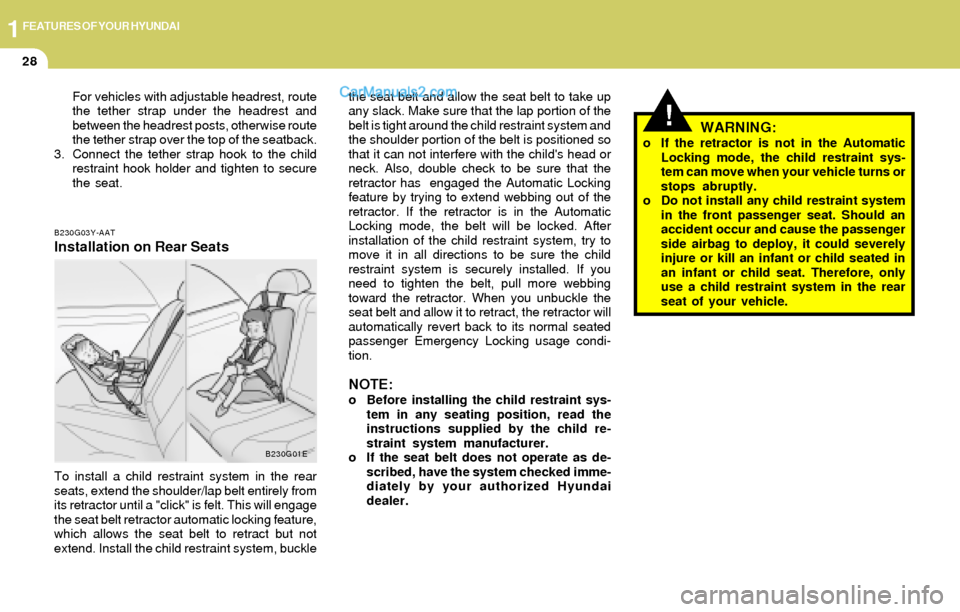
1FEATURES OF YOUR HYUNDAI
28
B230G03Y-AAT
Installation on Rear Seats
To install a child restraint system in the rear
seats, extend the shoulder/lap belt entirely from
its retractor until a "click" is felt. This will engage
the seat belt retractor automatic locking feature,
which allows the seat belt to retract but not
extend. Install the child restraint system, bucklethe seat belt and allow the seat belt to take up
any slack. Make sure that the lap portion of the
belt is tight around the child restraint system and
the shoulder portion of the belt is positioned so
that it can not interfere with the child's head or
neck. Also, double check to be sure that the
retractor has engaged the Automatic Locking
feature by trying to extend webbing out of the
retractor. If the retractor is in the Automatic
Locking mode, the belt will be locked. After
installation of the child restraint system, try to
move it in all directions to be sure the child
restraint system is securely installed. If you
need to tighten the belt, pull more webbing
toward the retractor. When you unbuckle the
seat belt and allow it to retract, the retractor will
automatically revert back to its normal seated
passenger Emergency Locking usage condi-
tion.
NOTE:o Before installing the child restraint sys-
tem in any seating position, read the
instructions supplied by the child re-
straint system manufacturer.
o If the seat belt does not operate as de-
scribed, have the system checked imme-
diately by your authorized Hyundai
dealer. For vehicles with adjustable headrest, route
the tether strap under the headrest and
between the headrest posts, otherwise route
the tether strap over the top of the seatback.
3. Connect the tether strap hook to the child
restraint hook holder and tighten to secure
the seat.
B230G01E
!WARNING:o If the retractor is not in the Automatic
Locking mode, the child restraint sys-
tem can move when your vehicle turns or
stops abruptly.
o Do not install any child restraint system
in the front passenger seat. Should an
accident occur and cause the passenger
side airbag to deploy, it could severely
injure or kill an infant or child seated in
an infant or child seat. Therefore, only
use a child restraint system in the rear
seat of your vehicle.
Page 40 of 241
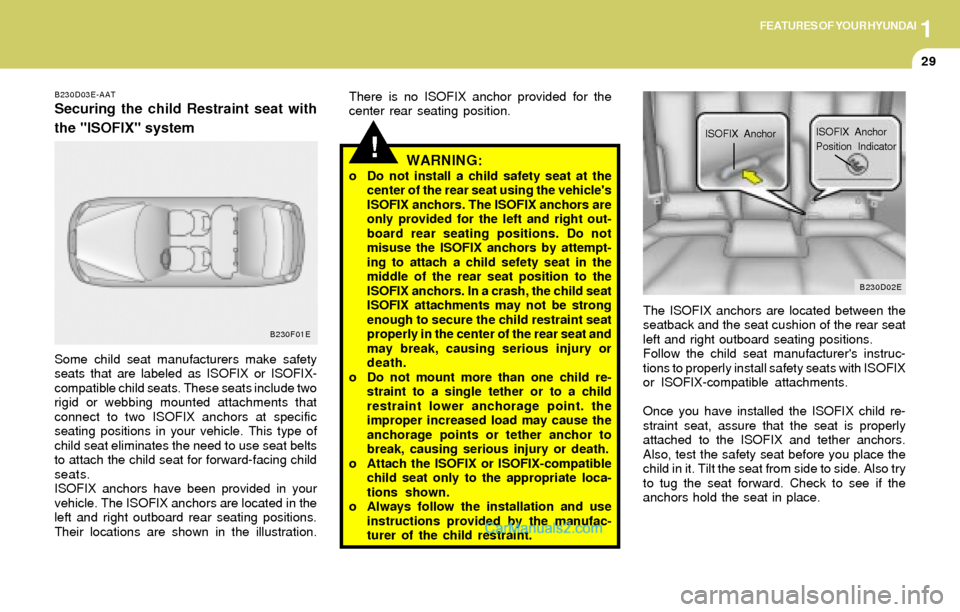
1FEATURES OF YOUR HYUNDAI
29
!
B230D03E-AAT
Securing the child Restraint seat with
the "ISOFIX" system
Some child seat manufacturers make safety
seats that are labeled as ISOFIX or ISOFIX-
compatible child seats. These seats include two
rigid or webbing mounted attachments that
connect to two ISOFIX anchors at specific
seating positions in your vehicle. This type of
child seat eliminates the need to use seat belts
to attach the child seat for forward-facing child
seats.
ISOFIX anchors have been provided in your
vehicle. The ISOFIX anchors are located in the
left and right outboard rear seating positions.
Their locations are shown in the illustration.There is no ISOFIX anchor provided for the
center rear seating position.
WARNING:o Do not install a child safety seat at the
center of the rear seat using the vehicle's
ISOFIX anchors. The ISOFIX anchors are
only provided for the left and right out-
board rear seating positions. Do not
misuse the ISOFIX anchors by attempt-
ing to attach a child sefety seat in the
middle of the rear seat position to the
ISOFIX anchors. In a crash, the child seat
ISOFIX attachments may not be strong
enough to secure the child restraint seat
properly in the center of the rear seat and
may break, causing serious injury or
death.
o Do not mount more than one child re-
straint to a single tether or to a child
restraint lower anchorage point. the
improper increased load may cause the
anchorage points or tether anchor to
break, causing serious injury or death.
o Attach the ISOFIX or ISOFIX-compatible
child seat only to the appropriate loca-
tions shown.
o Always follow the installation and use
instructions provided by the manufac-
turer of the child restraint.
B230F01E
The ISOFIX anchors are located between the
seatback and the seat cushion of the rear seat
left and right outboard seating positions.
Follow the child seat manufacturer's instruc-
tions to properly install safety seats with ISOFIX
or ISOFIX-compatible attachments.
Once you have installed the ISOFIX child re-
straint seat, assure that the seat is properly
attached to the ISOFIX and tether anchors.
Also, test the safety seat before you place the
child in it. Tilt the seat from side to side. Also try
to tug the seat forward. Check to see if the
anchors hold the seat in place.
ISOFIX Anchor
B230D02E
ISOFIX Anchor
Position Indicator
Page 84 of 241
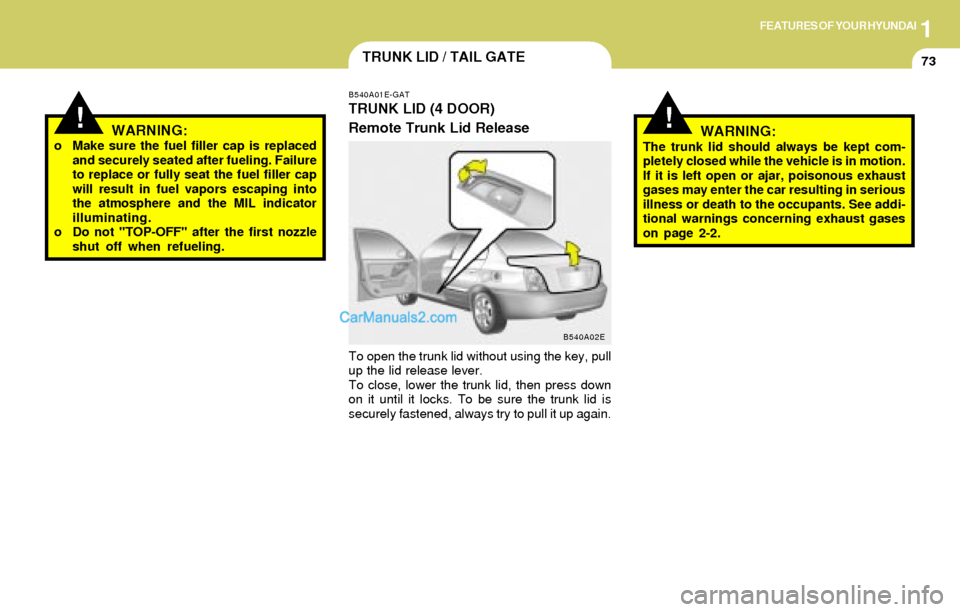
1FEATURES OF YOUR HYUNDAI
73
WARNING:The trunk lid should always be kept com-
pletely closed while the vehicle is in motion.
If it is left open or ajar, poisonous exhaust
gases may enter the car resulting in serious
illness or death to the occupants. See addi-
tional warnings concerning exhaust gases
on page 2-2.
!
B540A01E-GAT
TRUNK LID (4 DOOR)
Remote Trunk Lid Release
To open the trunk lid without using the key, pull
up the lid release lever.
To close, lower the trunk lid, then press down
on it until it locks. To be sure the trunk lid is
securely fastened, always try to pull it up again.
TRUNK LID / TAIL GATE
B540A02E
!WARNING:o Make sure the fuel filler cap is replaced
and securely seated after fueling. Failure
to replace or fully seat the fuel filler cap
will result in fuel vapors escaping into
the atmosphere and the MIL indicator
illuminating.
o Do not "TOP-OFF" after the first nozzle
shut off when refueling.